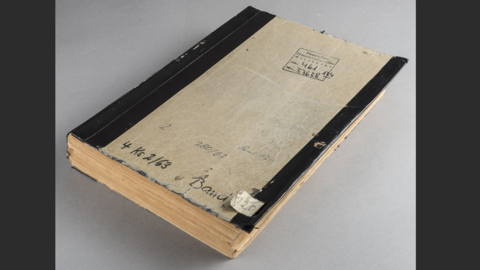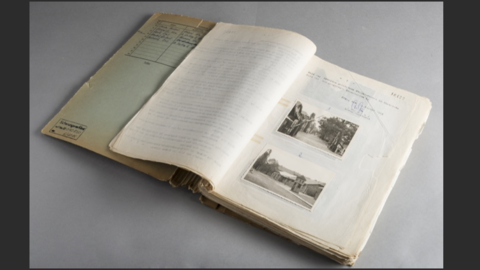The records of the first Frankfurt Auschwitz Trial total 456 volumes of files and 103 audiotapes. Of the 456 volumes covering the trial, 133 form the so-called main file that documents the investigations, the pre-trial hearings, the indictment, and the course of the proceedings conducted by the "jury court" (Schwurgericht) at the Regional Court, as well as the delivery of the judgments.
This main file starts with the investigations conducted by the Stuttgart public prosecutor’s office as of 1958, and by the Central Office in Ludwigsburg that had recently been established. After the Federal Court of Justice decided that the Frankfurt Regional Court would be the forum and venue for the Auschwitz case that had commenced, due to the energetic initiative of Fritz Bauer, the Frankfurt public prosecutors expanded the investigation in the summer of 1959.The public prosecutors interviewed numerous witnesses and compiled extensive written material. For the first time ever in the history of the Federal Republic of Germany, German public prosecutors crossed the "Iron Curtain" in 1960 to travel to Oświęcim, Poland and to examine the extermination site.
After two years of intensive investigations, the investigating judge Dr. Heinz Düx opened the pre-trial proceedings based on the 52 volumes of main files with records of about 600 interrogations in August 1961.The main file continued to grow through the additional records of the investigation during the course of the interrogation of witnesses and suspects, the body of evidence, and another judicial inspection of the crime scene by Associate Judge (Landgerichtsrat) Düx. In April 1963 finally, the investigations culminated in the indictment against Richard Baer, as the last commandant of Auschwitz I and the highest-ranking SS officer among the suspects, as well as against 22 other members of the SS and Emil Bednarek, a "kapo". The indictment prepared by the Jury Court of the Frankfurt Regional Court comprised 700 pages and 3 volumes. After Baer died in pre-trial custody on June 17, 1963, the case against the 22 defendants was cited formally as criminal proceedings against Mulka et al. Robert Mulka, who had been an adjutant to Rudolf Hoess, the Auschwitz camp commander in 1942/43, was then the highest-ranking member of the SS among the defendants.
The on-site visit by the court to the former Auschwitz Concentration Camp on December 14, 1964, with the 37 photos of the "judicial inspection" are among the most impressive of the 20 volumes of trial minutes. The trial ended with the judgments, which in written form comprise three volumes totaling 1275 pages. Other elements of these extensive records include, inter alia, the enforcement and pardon books (Vollstreckungshefte and Gnadenhefte), which provide information on whether and how the defendants served their sentences, in 29 volumes. In addition, there are the supplementary files (Beiakten), separate volumes (Sonderhefte), and seven volumes of press cuttings (Pressehefte). The Frankfurt public prosecutor’s office handed over the case files comprising 456 individual volumes of paper to the Hessian Main State Archives as the proper repository for such documents in 2001. There the file has been accessed for archival purposes and therefore, it can be researched in the Arcinsys archive information system. You may download accession to the case files as a PDF file using the classic finding-aid format (see below under "Further Information").






